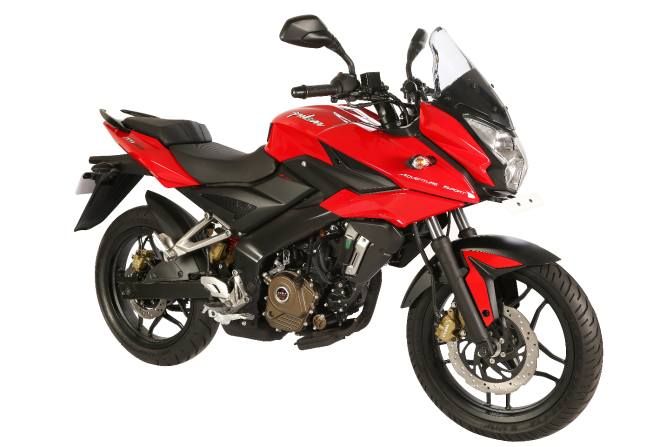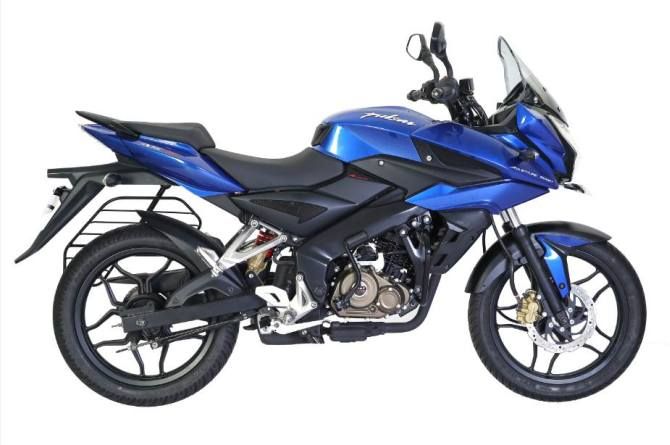 | « Back to article | Print this article |
Let's check out the exciting new features of the new Bajaj Pulsar AS 200 and AS 150.
Recently, Bajaj launched a new adventure sports bike under its flagship brand Pulsar with two models AS 150 and AS 200, priced at Rs 79,000 and Rs 91,550 (ex-showroom, Delhi) respectively. Both the bikes are almost identical in appearance; however, these two differ in their power mills and equipment.

Bajaj has launched these motorcycles as adventure bikes, meaning these could be generally made to ride off-road as well as on-road. However, the equipment on the Pulsar AS models are not much capable, so it's better we call them semi-faired or sport tourers. having said that, the the AS 150 and AS 200 are better machines than many other offerings in their respective segment.
Design and styling
The new Pulsar AS 150 and AS 200 are bolted on pressed steel perimeter frame, which have been adopted from the existing 200 NS model. Apart from the new fairing at the front, design and some dimensions of the motorcycles are also similar. Both the new motorcycles have overall dimensions (length x width x height) of 2,070mm x 804mm x 1,205mm along with a wheelbase of 1,363mm. Ground clearance of the AS 200 is 170mm, while that of the AS 150 is 3mm lesser, and it also weighs 10 kg lesser than the 153 kg AS 200.
Keeping all the bodywork of the 200 NS, the new Bajaj Pulsar Adventure Sport range also gets an 'Alpha Male' styled semi-fairing at the front, which makes it sportier. It incorporates a newly designed headlight including a projector lamp for better illumination and a fly-screen for wind protection. Other equipment like split-seat, clip-ons, console, wheels, under-belly exhaust and more remains unchanged. Both the motorcycles are available in three colour options: Red, Blue and Black.
Now the question is, how you can distinguish between the Pulsar AS 150 and AS 200 without looking at the monikers on the rear cowl? The front disc of the AS 150 is smaller and it also misses the rear disc brake, seen on the AS 200. You can also look for a starting kick on the younger one, and its wheel and tyres are also skinnier than the its more powerful sibling.
Engine and performance

Both the new adventure sport motorcycles feature 4-valve, DTS-i engines for optimum performance delivery. Where the Bajaj Pulsar AS 200 shares the existing 199.5cc, liquid cooled motor with the 200NS, the AS 150 gets an all new 149.5cc, air-cooled mill.
Engine propelling the AS 200 comes mated to a 6-speed, 1-down 5-up shift, constant mesh gearbox using a wet, multi-plate clutch arrangement. With Bajaj's revolutionary triple-spark DTS-i technology and a carburetor type fuel supply, it makes power up to 23.2bhp at 9,500rpm and torque up to 18.3Nm at 8,000rpm, exactly similar to the 200 NS (Naked Sport).
The new engine powering the Pulsar AS 150 claims best-in-class performance with a maximum power output of 16.8bhp at 9,500rpm and a peak torque of 13Nm at 7,000. It comes mated to a 5-speed, 1-down and 4-up shift gearbox and uses twin-spark DTS-i technology along with a carburetor type fuel supply.
Suspension setup
Both the adventure sport Pulsars feature an adjustable Nitrox mono-shock at the rear with gas reservoir. However, the telescopic forks with anti-friction bush at the front differs in diameter. The inner tube diameter of the forks in the AS 200 is 37mm, while that in the AS 150 is 33mm.
Brakes
Bajaj Pulsar AS 200 has a Bybre dual disc braking system with 280mm and 230mm disc at the front and the rear respectively. While the AS 150 gets a 240mm disc brake at the front and a 130mm drum brake at the rear, both the braking systems have been designed according to the power delivery of the motorcycles.
Wheels and tyres
Wheel design and diameter are same in the adventure sport range, however, they differ in the width. Both the bikes have MRF zapper tyres, which vary in size. The AS 150 has 80/100 section front and 110/80 section rear, while the AS 200 features wider 100/80 section front and 130/70 section rear tubeless tyres.
Overall, both the adventure sport motorcycles are looking fresh offerings in their respective segment and are strong contenders against competition. With the best-in-class performance, Bajaj Pulsar AS 150 competes with the bikes like Yamaha Fazer and Suzuki Gixxer SF, while we don't have any other option of a faired tourer against Pulsar AS 200.